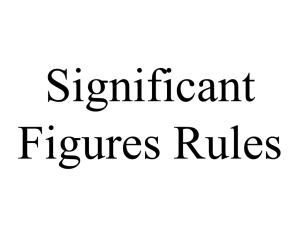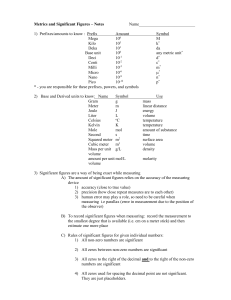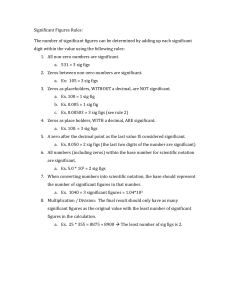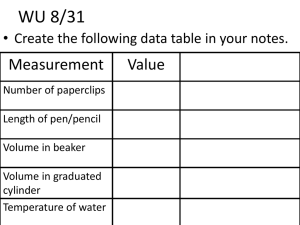ppt - Physics Rocks!
advertisement
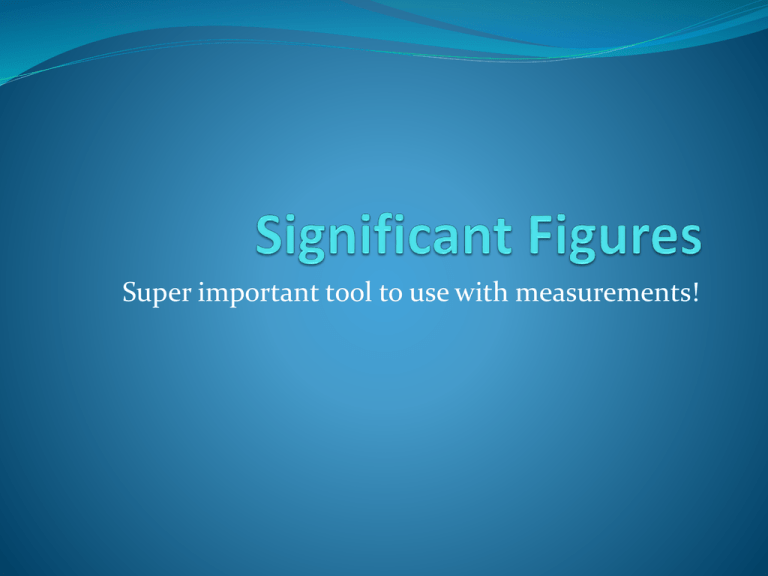
Super important tool to use with measurements! Significant Figures (sig. figs.) All digits in a measurement that are known for certain, plus the first estimated (uncertain) digit Sig figs give an indication of the degree of precision for a measurement and/or a calculation ONLY used when a number is (or is assumed to be) a measurement EXACT quantities do not have “sig figs” Examples: there are exactly 100 cm in 1 m By definition, 1 inch = 2.54 cm Fractions in equations (1/2 or 0.5 as a multiplier) How many significant figures are in the following measurement: 3508.2 g How many significant figures are in the following measurement: 3508.2 g 5 Rules: All non-zero values ARE significant All zeros between non-zero digits ARE significant How many significant figures are in the following measurement: 0.00065 s How many significant figures are in the following measurement: 0.00065 s 2 Rule: For numbers LESS THAN 1: Zeros directly after the decimal point are NOT significant The zeros at the beginning are simply placeholders You can rewrite the number with new units or in scientific notation, and the zeros will drop out. How many significant figures are in the following measurement: 1500 g How many significant figures are in the following measurement: 1500 g 2 Rule: All non-zero values ARE significant If there is no decimal point, then the zeros at the end of a number (after the last non-zero digit) are insignificant. These zeros are placeholders—we can rewrite the value with different units or in scientific notation and the zeros will drop out. How many significant figures are in the following measurement: 0.007250 W How many significant figures are in the following measurement: 0.007250 W 4 Rule: A zero to the right of a decimal AND following a non-zero digit IS significant The last zero is not a placeholder—it is showing the level of precision of the measurement. The first 3 zeros are still placeholders, so not significant How many significant figures are in the following measurement: 105.00 cm How many significant figures are in the following measurement: 105.00 cm 5 Rules: All non-zero values ARE significant All zeros between non-zero digits ARE significant A zero to the right of a decimal AND following a nonzero digit IS significant What is the answer to the following calculation, written in proper sig. figs: 1.25 cm + 6.5 cm + 11.75 cm + 0.055 cm What is the answer to the following calculation, written in proper sig. figs: 1.25 cm + 6.5 cm + 11.75 cm + 0.055 cm = 19.555 ≈ 𝟏𝟗. 𝟔 𝒄𝒎 Rule: When adding or subtracting: Your answer must have the same degree of precision as the least precise measurement (that means…go to the fewest number of decimal places, if there are decimal places in use) What is the answer to the following calculation, written to proper sig figs: 25.50 m * 12.057 m * 0.095 m What is the answer to the following calculation, written to proper sig figs: 25.50 m * 12.057 m * 0.095 m = 29.208 𝑚3 ≈ 𝟐𝟗 𝑚3 Rule: When multiplying and dividing: The number of sig figs in the answer is equal to the least number of sig figs in any of the measurements used in the calculation Scientific notation and sig figs Use Scientific notation when you need to specify how many zeros are significant i.e. Write 1500 N with 3 s.f. The best way to do this is with scientific notation: 1.50 x 103 N Write 10600 kg with 4 s.f. 1.060 𝑥 104 𝑘𝑔 Note on book problems: Most of the problems in your book will have values which look like they only have 1 s.f. Assume that all digits in book problems are significant i.e. if a problem says that an object has a mass of 100 kg, please treat that as 3 s.f. As long as you don’t go overboard, don’t worry about sig figs in your WebAssign problems—wait until the very end for any rounding! We’ll be a lot pickier in your labs and quizzes/tests!
